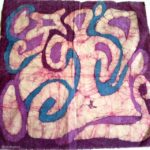I remember my first tie-dye experiment — I was at a birthday party, and we’d all been given white t-shirts and rubber bands so that we could create our own patterns and then dip our shirts into the bins of color. I chose yellow and purple, and eagerly attempted to create a beautiful, brightly-colored shirt I could show off to my friends. It did not go as planned. I’m not sure if the dye wasn’t strong enough, or if I didn’t hold the shirt under long enough, or if I just expected too much of a simple activity. But I decided then and there that I was pretty much done with fabric dyeing if it was going to yield such dismal results (I was a very serious, stubborn child and didn’t have time to turn my room into a dye factory to test out on an array of shirts).
Later, however, I had a friend whose mother worked with textiles, and I loved watching her weave and dye and spin, and I wondered if there were more to the art than I previously thought. I also enjoyed a home economics project where we marbled paper, which turned out much better than the aforementioned tie dye incident. So I decided to try again.
Now, of course, I’m aware that there are hundreds of ways to dye fabric, along with plenty of different dyes to try, and new techniques and products coming out all the time. This year I’ll be using a commercial dye to color my old wedding dress so that I can wear it for a convention as a costume. Looking through the various ways to do this has opened my eyes to all the possibilities and I’m eager to try smaller projects in order to experiment with all the ways in which dye can enhance a piece of fabric.
One of my favorite ways is, of course, marbling. It’s a little more complicated than some other methods, but the results are simply stunning. Sugar & Charm has an excellent tutorial with lots of photos of the fabric in-process and afterwards. In order to dye fabric in this way, you’ll need a few special ingredients, such as alum, acrylic paint, and methocel. These can all be ordered off of Amazon, but might also be available at your local hobby store.
If that method seems a bit intimidating, you could try the easier, but still beautiful, Batik method, which has been used for hundreds of years. Pear Mama’s walkthrough of the process is simple, and the only materials you’ll need are glue, craft paint, and a paintbrush. It’s easier to create clean designs with this process, and the simple designs done in glue will stand out above whichever color you choose to dye the fabric.
Ice dyeing is another popular option for fabric coloration, although it too requires some special materials, though fewer than the marbling technique. You’ll need to purchase some ash and procion dye, as well as a bag of ice. Though many dyeing tutorials suggest using cotton, this particular tutorial from JoJoTastic suggests using linen instead.
Don’t know what to use your dyed fabric for? If you want to start small, you can dye table napkins, scarves, or pieces of fabric to make into pouches, purses, bags, or hats. If you want to take on something larger, you can dye fabric to make into clothes, a backdrop (especially helpful if you’re a photographer or model, or want an eye-catching statement piece to hang in your home), or even a tent for the kids. There are many, many ways to use this fabric, but using them for simple projects is the best, as it allows the fantastic dye job you did stand out.
Want to try one of these methods out? You can find the Ice Dye tutorial at JoJoTastic, the Batik process at Pear Mama, and the Marbling technique at Sugar & Cream. You don’t have to do this alone, either. It’s way more fun to invite a few friends over and enjoy an afternoon of creativity together. You could even trade fabrics if someone fancies how yours turned out, and if you spot someone else’s piece that would make the perfect pillowcase or skirt.



